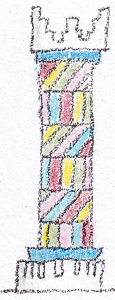Dalran Polytheism
Like many other people of the Zamra Mountains, the Dalrans originally made no altars, statues or temples to their deities, instead performed rituals near sacred mountains, lakes or boulders while facing the sun or whatever light source available. The practice of erecting altars and shrines became more common through contact with lowland cultures as Dalra expanded across eastern Emlas, especially after the royal court was moved to the city of Kilí, where sacred fires now burn for worshippers to face towards during prayers.
Aka Ortí is the god of wisdom and patron deity of the dalrans, whom all people of the empire must venerate before all other gods. He's associated with light -whether in form of the sun, fire, stars or lightnings-, shiny things -such as precious stones and metals-, rainbows and bright colours in general.
Aka Ortí is associated with the sacred mountains, especially Mt. Sóm, where monarchs and other members of the royal family make annual pilgrimage to its peak and offer gold, precious stones and colourful cloth to him on an altar there.
Giþraló is the goddess of horses and protector of merchants, messengers and travelers in general.
Malþó is the dalran goddess of the earth, springs, streams and rivers, though nowadays she has acquired the roles and features of many other fertility goddesses worshipped in Dalra.
Ókóta, also known as Ohóta, Okóþe and Ókó, is the goddess of rain and a kind of celestial counterpart of Malþó.
Súrbast is the god of shadows and the night.
Þetexales is the dalran version of a creator god worshipped by most people in eastern Emlas.
Jamas is the son of the goddess Malþó in dalran mythology, believed to have emerged from Eþekala Lake in the Zamra Mountains, wandered around the world and defeated monsters so humanity could prosper, before returning to the lake and disappeared. Dalrans believe that Jamas will return when the world needs him again, and honour him by giving offerings on Naþólix Island in the middle of the lake.
Similar myths of culture heroes who helped mankind and then left are found throughout Emlas and Túlmikkía, particularly among Orrólans and Enans.
The Húlpakrans along the northwestern coast of Úrtal Sea believe in iknalúns as well -though depicted as half men, half bears-, where they are believed to snatch children away and eat them unless offered libations of wine at full moon.
Notable deities
Aka Ortí
Dalran:Aka Ortí is the god of wisdom and patron deity of the dalrans, whom all people of the empire must venerate before all other gods. He's associated with light -whether in form of the sun, fire, stars or lightnings-, shiny things -such as precious stones and metals-, rainbows and bright colours in general.
Aka Ortí is associated with the sacred mountains, especially Mt. Sóm, where monarchs and other members of the royal family make annual pilgrimage to its peak and offer gold, precious stones and colourful cloth to him on an altar there.
Giþraló
Dalran:Giþraló is the goddess of horses and protector of merchants, messengers and travelers in general.
Malþó
Dalran:Malþó is the dalran goddess of the earth, springs, streams and rivers, though nowadays she has acquired the roles and features of many other fertility goddesses worshipped in Dalra.
Ókóta
Dalran:Ókóta, also known as Ohóta, Okóþe and Ókó, is the goddess of rain and a kind of celestial counterpart of Malþó.
Súrbast
Dalran:Súrbast is the god of shadows and the night.
Þetexales
Dalran:Þetexales is the dalran version of a creator god worshipped by most people in eastern Emlas.
Heroes
Jamas
Dalran:Jamas is the son of the goddess Malþó in dalran mythology, believed to have emerged from Eþekala Lake in the Zamra Mountains, wandered around the world and defeated monsters so humanity could prosper, before returning to the lake and disappeared. Dalrans believe that Jamas will return when the world needs him again, and honour him by giving offerings on Naþólix Island in the middle of the lake.
Similar myths of culture heroes who helped mankind and then left are found throughout Emlas and Túlmikkía, particularly among Orrólans and Enans.
Monsters
Iknalúns
Iknalúns are usually depicted as a kind of bear-centaurs or, more rarely, as bears with human faces. They are associated with wine and viticulture in general, and are believed to curse vineyards unless they're offered jugs of wine at their sacred groves before festivals.The Húlpakrans along the northwestern coast of Úrtal Sea believe in iknalúns as well -though depicted as half men, half bears-, where they are believed to snatch children away and eat them unless offered libations of wine at full moon.
Þróls
Þróls are usually depicted as satyr-like creatures with legs and ears of a donkey, who are believed to sneak up on people and kick them off cliffs and into ravines.Funerary practices
Dalrans neither cremate nor bury their dead and begrudgingly tolerate either practices among other cultures in Dalra, instead they inter them in above-ground mausoleums or in caves in sacred mountains. Traditionally, dalran mausoleums are shaped like pillars, with smaller ones housing individuals along with grave goods and larger ones having multiple chambers stacked on top of each other. These funerary pillars are often shaped like watchtowers, painted and sometimes gilded, and are common in the city of Sarka, the old capital where members of the royal family are laid to rest.











Comments